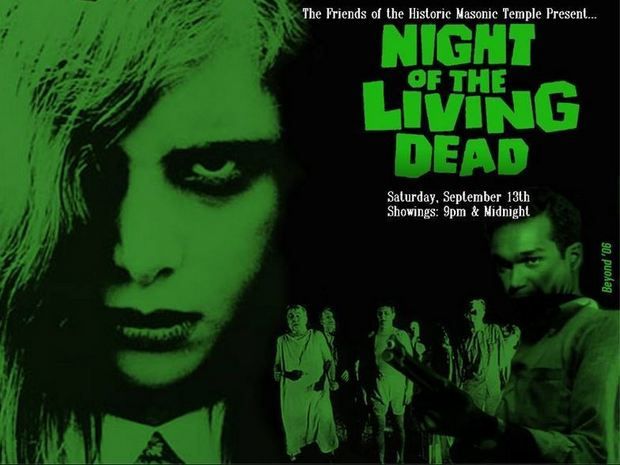Fall may not have arrived yet, but for the more morbid among us, the winding down of summer means Halloween is crawling into view. In anticipation of it, and to raise money for one of Bay City’s most historic buildin
The women’s plan is to make “Night of the Living Dead” the first installment in a series. They selected it as their first pick for several reasons.
“It kicked off the zombie craze that’s been happening these past few years,” Curtis said. “It’s really the first accepted zombie movie in the genre.”
“Night of the Living Dead” was released in 1968 and stands as the Book of Genesis for all subsequent zombie culture. In the film, writer and director George A. Romero invented the modern zombie, in the same way Bram Stoker crafted our contemporary view of vampires.
Just as vampire legends existed for millennia before Stoker’s “Dracula,” zombie mythology and films also predated Romero’s work. However, prior to “Night of the Living Dead,” cinematic zombies were portrayed as slaves magically resurrected by and subservient to a voodoo bokor. Their presence in horror films of the ’40s and ’50s was borne of American ignorance and exploitation of syncretic African-Christian religions such as Vodou and Santeria, in turn casting enduring negative perspectives on those faiths. The word “zombie,” for instance, is believed to stem from “nzambi,” meaning “god” in the Central African Bantu language of Tshiluba.
Romero in “Night of the Living Dead” changed the very definition of what a zombie is.
The undead’s instinctual craving for human flesh, the shambling gait, their unstoppable herd nature, the necessity to disable their brains to kill them — all of these tropes now standard to the genre were contributed by Romero. And yet, Romero’s most pertinent contribution to zombie form is the apocalyptic nature now innate to the concept. In his hands, zombies were no longer the result of a mad hoodoo priest, localized to a specific region. Now they were a worldwide plague, amounting to humanity’s extinction event. Society crumbles and survivors must scavenge for resources, knowing that all the while, they will eventually become zombies themselves.
This doomsday hopelessness Romero imbued to the brand now seems inherent to it. And yet, this aspect is the device that sets the stage for the genre’s main concern and tragedy — humans’ inability to work together and avert their mutually assured destruction. As such, Romero’s zombies are a springboard for social criticism and cultural reflection, the undead reflecting our species’ own failings. Thus, the litmus test for gauging whether or not a zombie film is done right is to see if its creators recognize this and focus on the human drama resulting from the undead’s havoc, rather than serving as a vehicle for mindless blood and gore.
Among “Night of the Living Dead”‘s progeny are sequels “Dawn of the Dead” (1978) and “Day of the Dead” (1985), which collectively stand as arguably the greatest trilogy in horror. Unfortunately, Romero lost his Midas touch and severely tarnished his legacy by creating a second, abysmal trilogy in “Land of the Dead,” “Diary of the Dead,” and “Survival of the Dead,” all cranked-out in a four-year period from 2005 to 2009. Apparently, taking a few decades’ break from the genre caused Romero to forget how he made it great in the first place.
Aside from the literal sequels, the descendant of “Night of the Living Dead” most readers will be familiar with is AMC’s “The Walking Dead,” the most popular cable drama in TV history. Creator Robert Kirkman has not been shy in crediting Romero with his iteration of the zombies, adhering to the rules set forth by the original film. If you’re a fan of that show, you owe it to yourself to see where it all started.
As Curtis said, “You can see how current zombie movies build on this, so we thought, ‘Why not show the original?'”
“It’s just very much a classic and we just thought it was a perfect first,” Kent added.
As an added bonus, “Night of the Living Dead” is in the public domain, meaning there is no overhead to pay for the rights to screen it. This is because in its initial screenings, it was titled “Night of the Flesh Eaters” and copyright was attached to that. The title was soon changed to its more familiar name for its theatrical release, but per the law of the time, the copyright did not transfer. As such, the filmmakers made nothing from it, though it grossed $12 million domestically and cost about $114,000 to make.
For future films in the series, Kent and Curtis are looking to get presenting sponsors to contribute $250 to bring other landmark horror films, such as “Halloween” and “Evil Dead.”
“Whether it’s a quarterly series or a monthly series or however we do it, we want to start showing them more often,” Kent said.
Despite the public uproar that accompanied “Night of the Living Dead” upon its release due to its violence, cannibalism, brief nudity, overall subject matter, and having a male black lead in the midst of the African-American Civil Rights Movement, the film has received its just recognition in the following decades. Most notably, the Library of Congress in 1999 added it to the National Film Registry, officially sanctioning it as “culturally, historically or aesthetically significant.”
At 46 years old but with a pervasive influence, the film appeals to a wide range of demographics, Kent and Curtis said.
“There’s nostalgia there for older people and for young high school kids to get into something new,” Kent said.
Curtis added they might have volunteers in zombie makeup at the event, and they’re encouraging attendees to ghoul themselves up as well to add to the creepily fun ambience.
The film aside, the women stressed that it’s all a pretext to bringing awareness to its venue.
“The biggest thing is raising money to restore the building,” Kent said.

